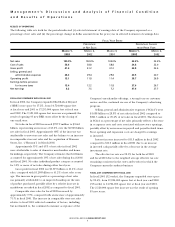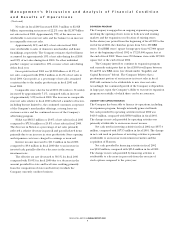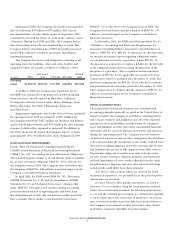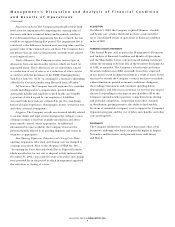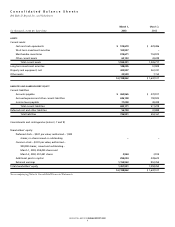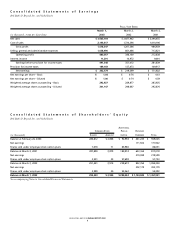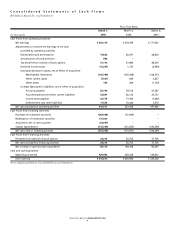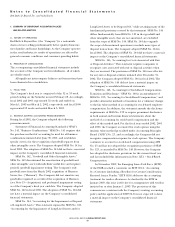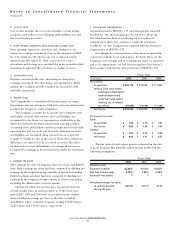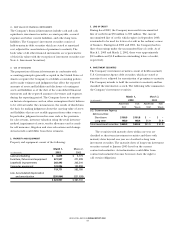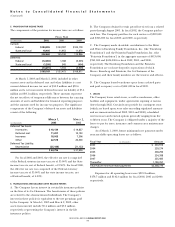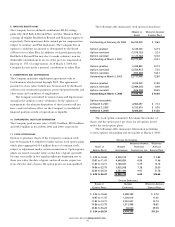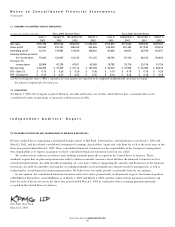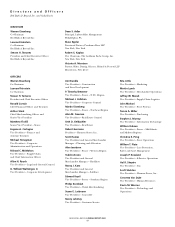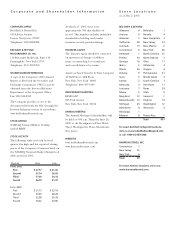Bed, Bath and Beyond 2002 Annual Report Download - page 15
Download and view the complete annual report
Please find page 15 of the 2002 Bed, Bath and Beyond annual report below. You can navigate through the pages in the report by either clicking on the pages listed below, or by using the keyword search tool below to find specific information within the annual report.
BED BATH & BEYOND ANNUAL REPORT 2002
13
U. FAIR VALUE OF FINANCIAL INSTRUMENTS
The Company’s financial instruments include cash and cash
equivalents, investment securities, accounts payable, accrued
expenses and other current liabilities, and other long term
liabilities. The Company’s investment securities consist of
held-to-maturity debt securities which are stated at amortized
cost, adjusted for amortization of premium to maturity. The
book value of all other financial instruments are representative
of their fair values with the exception of investment securities (see
Note 4 - Investment Securities).
V. USE OF ESTIMATES
The preparation of financial statements in conformity with
accounting principles generally accepted in the United States of
America requires the Company to establish accounting policies
and to make estimates and judgments that affect the reported
amounts of assets and liabilities and disclosure of contingent
assets and liabilities as of the date of the consolidated financial
statements and the reported amounts of revenues and expenses
during the reporting period. The Company bases its estimates
on historical experience and on other assumptions that it believes
to be relevant under the circumstances, the results of which form
the basis for making judgments about the carrying value of assets
and liabilities that are not readily apparent from other sources.
In particular, judgment is used in areas such as the provision
for sales returns, inventory valuation using the retail inventory
method, impairment of assets, vendor allowances and accruals
for self insurance, litigation and store relocations and closings.
Actual results could differ from these estimates.
2. PROPERTY AND EQUIPMENT
Property and equipment consist of the following:
March 1, MARCH 2,
(in thousands) 2003 2002
Land and building $ 6,875)$ 5,173)
Furniture, fixtures and equipment 321,507)271,399)
Leasehold improvements 268,493)205,310)
Computer equipment 122,896)100,898)
719,771)582,780)
Less: Accumulated depreciation
and amortization (295,864) (221,039)
$ 423,907)$ 361,741)
3. LINE OF CREDIT
During fiscal 2002, the Company increased its uncommitted
line of credit from $50 million to $75 million. The current
uncommitted line of credit, which expires in September 2003,
is intended to be used for letters of credit in the ordinary course
of business. During fiscal 2002 and 2001, the Company had no
direct borrowings under the uncommitted line of credit. As of
March 1, 2003 and March 2, 2002, there were approximately
$8.5 million and $5.8 million in outstanding letters of credit,
respectively.
4. INVESTMENT SECURITIES
The Company’s investment securities consist of held-to-maturity
U.S. Government Agency debt securities, which are stated at
amortized cost, adjusted for amortization of premium to maturity.
The Company intends to hold the securities to maturity and has
classified the investments as such. The following table summarizes
the Company’s investment securities:
March 1, March 2,
(in thousands) 2003 2002
AMORTIZED FAIR AMORTIZED FAIR
COST VALUE COST VALUE
U.S. Government Agency
debt securities:
Short term $100.9 $101.8 $– $ –
Long term 148.0 148.4 51.9 51.9
Total investment securities $248.9 $250.2 $51.9 $ 51.9
The securities with maturity dates within one year are
classified as short term investment securities and those with
maturity dates beyond one year are classified as long term
investment securities. The maturity dates of long term investment
securities extend to January 2005 based on the current
contractual maturities. Actual maturities could differ from
contractual maturities because borrowers have the right to
call certain obligations.


